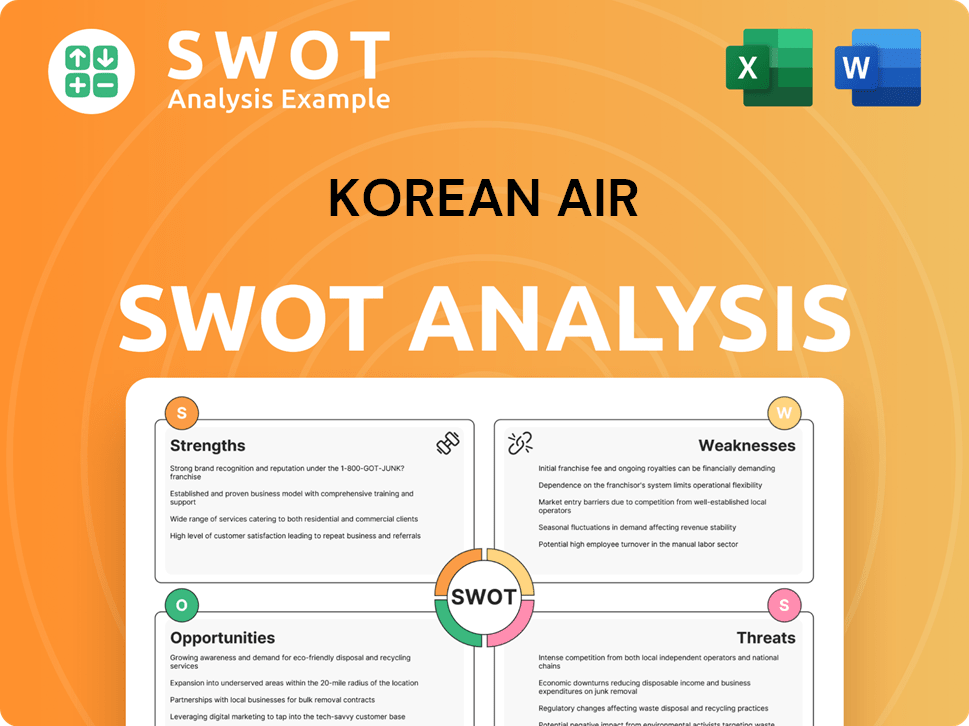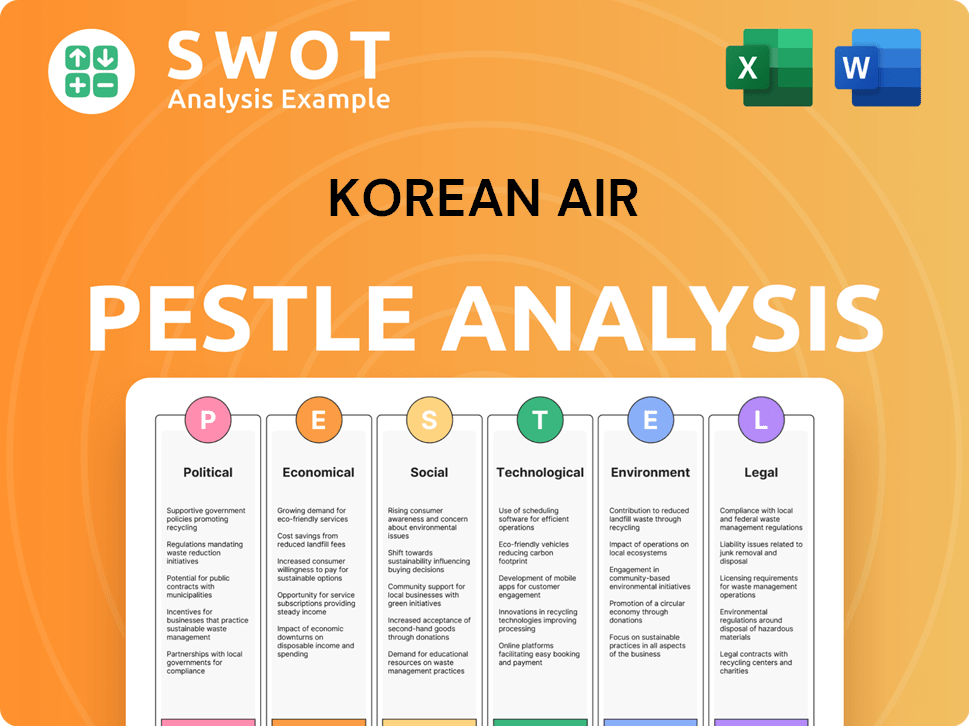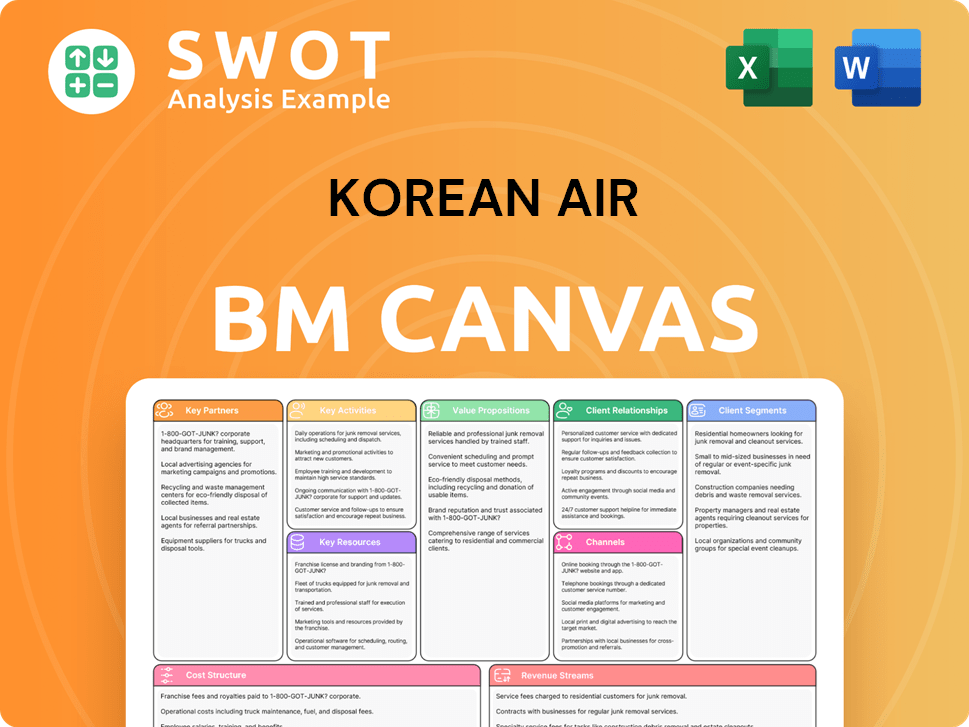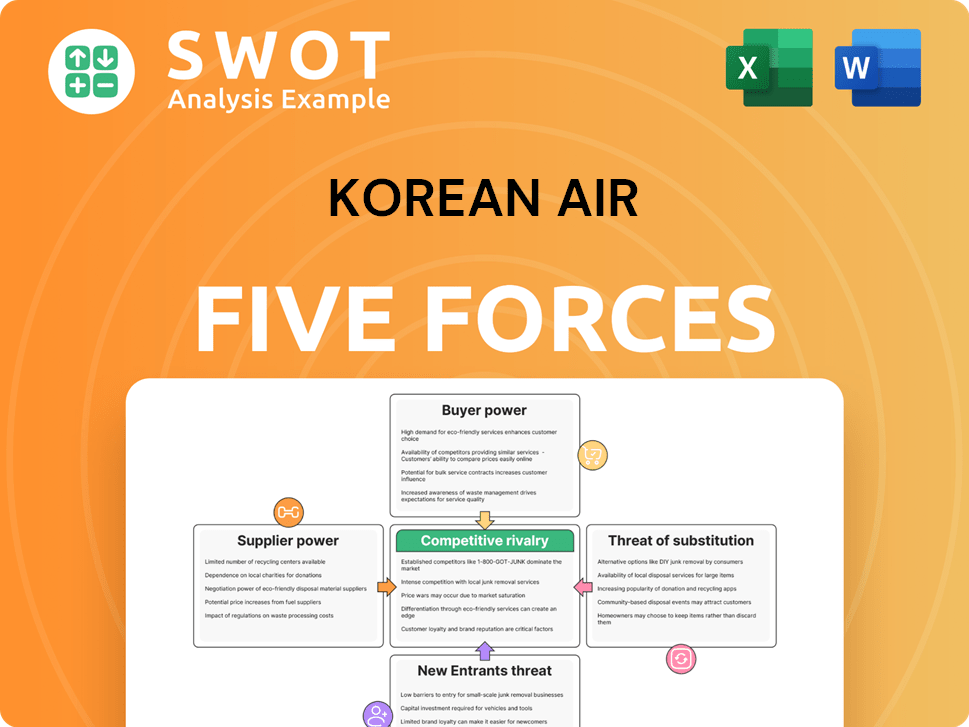Korean Air Bundle
How is Korean Air Soaring in the Skies of Sales and Marketing?
Korean Air, South Korea's premier airline, is not just flying; it's transforming its approach to reach new heights. With a significant brand refresh in March 2025 and a finalized merger with Asiana Airlines in December 2024, the airline is redefining its global presence. This strategic shift, coupled with record-breaking revenue in 2024, showcases Korean Air's innovative sales and marketing strategies.

This in-depth analysis will uncover the Korean Air SWOT Analysis, exploring its dynamic sales and marketing tactics. We'll delve into the core of Korean Air's marketing plan, examining its competitive advantage through detailed market analysis and the evolution of its brand. From its digital marketing strategy to its international expansion strategy, discover how Korean Air generates revenue and builds customer loyalty, addressing marketing challenges and achieving remarkable sales performance.
How Does Korean Air Reach Its Customers?
The sales strategy of Korean Air encompasses a multifaceted approach, utilizing both online and offline channels to maximize market reach. This strategy is crucial for maintaining its competitive advantage in the aviation industry. The company's marketing plan is designed to adapt to changing consumer behaviors and technological advancements, ensuring a seamless customer experience.
Korean Air's approach to sales channels is a key component of its overall marketing strategy. The airline has invested in digital transformation, partnerships, and IT system modernization to enhance customer satisfaction and operational efficiency. This integrated approach supports the airline's brand and revenue generation strategies.
The airline's sales and marketing tactics are designed to capture a broad customer base, leveraging both direct and indirect channels. This strategy supports its international expansion strategy and aims to increase its market share, particularly in the Asian market.
Korean Air's primary online sales channels include its official website and e-commerce platforms. These platforms were significantly enhanced in 2019 through a partnership with Amadeus, improving the booking and check-in processes. The enhancements included a 'shopping cart-centered' feature to save selections.
Offline sales channels include physical retail locations and direct sales teams. These channels have evolved, with a strategic shift towards digital adoption and omnichannel integration. This evolution is driven by the need to meet customer demands and manage increasing data volumes.
Korean Air has partnered with Accelya to integrate their New Distribution Capability (NDC) and FLX-Merchandizing module. This modernization allows the airline to offer personalized services across direct and indirect channels, including over 50,000 travel agents. The airline also collaborates with Expedia Group Media Solutions for off-site advertising.
Continuous IT system modernization is a key focus for ensuring fast, reliable, and scalable operations. This focus contributes to enhanced customer satisfaction and operational efficiency. The airline's commitment to technological advancements supports its Growth Strategy of Korean Air.
Korean Air's sales strategy focuses on a blend of online and offline channels, supported by strategic partnerships and IT advancements. This integrated approach helps the airline meet the demands of its target audience segmentation.
- Digital Transformation: Upgrading online platforms for better user experience and functionality.
- Partnerships: Collaborating with travel agencies and media solutions to expand reach.
- Omnichannel Integration: Providing a seamless experience across all sales channels.
- IT Modernization: Ensuring fast, reliable, and scalable operations to enhance customer satisfaction.
Korean Air SWOT Analysis
- Complete SWOT Breakdown
- Fully Customizable
- Editable in Excel & Word
- Professional Formatting
- Investor-Ready Format

What Marketing Tactics Does Korean Air Use?
The Korean Air marketing strategy is a multifaceted approach designed to boost sales and strengthen its brand presence. It combines digital and traditional marketing tactics to reach a broad audience and drive customer engagement. This strategy includes leveraging various digital channels, influencer partnerships, and data-driven marketing techniques to enhance customer experiences and improve operational efficiency.
Korean Air focuses on digital marketing, including content marketing, SEO, paid advertising, and social media. The airline also uses off-site advertising solutions to target specific audiences. Furthermore, they have embraced influencer partnerships to increase brand visibility and credibility. In the competitive South Korean market, a localized digital marketing strategy is essential, focusing on platforms like Naver and KakaoTalk.
Data-driven marketing, customer segmentation, and personalization are central to Korean Air's strategy. By analyzing customer preferences, the airline aims to provide tailored offers and experiences. They are also developing an AI Contact Center in partnership with Amazon Web Services (AWS) to streamline customer support. This move aims to improve customer satisfaction and loyalty through AI-powered voice bots and chatbots, which is expected to be completed by February 2026.
Korean Air utilizes various digital marketing tactics to engage customers and drive sales. This includes content marketing, SEO, paid advertising, and social media campaigns. The airline also uses email marketing to communicate with customers.
The airline collaborates with influencers, including celebrities and environmental activists, to enhance brand visibility and credibility. These partnerships help promote campaigns and increase brand recognition. This strategy is particularly effective in reaching a wider audience.
In South Korea, Korean Air focuses on localized digital marketing strategies. This involves using platforms like Naver for SEO, blogs, and shopping, as well as KakaoTalk for direct customer engagement. These platforms are crucial for reaching the local market effectively.
Korean Air is investing in data-driven marketing, customer segmentation, and personalization. By analyzing customer data, the airline aims to tailor offers and experiences. This approach improves customer satisfaction and loyalty.
The airline is developing an AI Contact Center (AICC) in partnership with Amazon Web Services (AWS). This center will streamline call center operations and provide personalized customer support through AI-powered voice bots and chatbots. The expected completion date is February 2026.
Korean Air utilizes off-site advertising solutions, such as those offered by Expedia Group, to reach highly qualified audiences. These campaigns have achieved a 10:1 return on ad spend in campaigns aimed at increasing bookings from U.S. travelers.
Korean Air's marketing plan incorporates a mix of digital and traditional strategies to enhance its brand and drive sales. These tactics are designed to reach a wide audience and provide personalized customer experiences.
- Digital Marketing: Content marketing, SEO, paid advertising, and social media campaigns.
- Influencer Partnerships: Collaborations with celebrities and activists to boost brand visibility.
- Localized Strategies: Focus on platforms like Naver and KakaoTalk in South Korea.
- Data-Driven Marketing: Customer segmentation and personalization to tailor offers.
- AI Contact Center: Development of an AI-powered customer support system.
- Off-Site Advertising: Utilizing platforms like Expedia for targeted campaigns.
Korean Air PESTLE Analysis
- Covers All 6 PESTLE Categories
- No Research Needed – Save Hours of Work
- Built by Experts, Trusted by Consultants
- Instant Download, Ready to Use
- 100% Editable, Fully Customizable

How Is Korean Air Positioned in the Market?
The brand positioning of Korean Air centers on excellence, reliability, and sophistication, deeply rooted in its Korean heritage while embracing a global appeal. This strategy is crucial for its Korean Air sales strategy and overall Korean Air marketing plan. The airline aims to provide a premium experience, reflected in its visual identity and service offerings.
In March 2025, the airline unveiled a refined brand identity, designed by Lippincott, including a reimagined Taeguk symbol and a modernized logotype. The rebrand is designed to solidify its position as a premium global airline, especially after its merger with Asiana Airlines. This evolution is a key component of its Korean Air brand strategy. The updated visual identity, including aircraft livery with a metallic blue finish and refined cabin designs, reinforces a premium, hospitality-led experience.
This focus on quality and customer satisfaction is visually represented by its logo, which features an elegant emblem of the Yin and Yang, symbolizing the harmony of tradition and modernity. This commitment to quality and customer satisfaction is a core element of its Korean Air marketing strategy. The airline appeals to its target audience through a commitment to innovation and a focus on sustainability, which is crucial for its Korean Air market analysis.
The brand blends Korean heritage with modern design elements, creating a unique identity. The Yin and Yang symbol represents harmony, reflecting the balance between tradition and innovation. This approach is central to how Brief History of Korean Air has evolved over time.
Korean Air positions itself as a premium airline, focusing on high-quality service and luxurious experiences. This includes redesigned cabins and refined inflight services. The goal is to provide a seamless and luxurious customer experience.
The airline is integrating sustainability into its operations to appeal to environmentally conscious travelers. Korean Air has been actively integrating sustainability into its operations, evidenced by its initiative to use domestically produced Sustainable Aviation Fuel (SAF) for commercial flights starting August 2024. This commitment is a key element of its Korean Air sales and marketing tactics.
Korean Air aims for a global presence, appealing to international travelers while maintaining its Korean identity. This strategy is crucial for its international expansion strategy. The brand consistently maintains its image across various touchpoints, from digital platforms to in-flight services.
Korean Air Business Model Canvas
- Complete 9-Block Business Model Canvas
- Effortlessly Communicate Your Business Strategy
- Investor-Ready BMC Format
- 100% Editable and Customizable
- Clear and Structured Layout

What Are Korean Air’s Most Notable Campaigns?
The Korean Air sales strategy and Korean Air marketing strategy have been significantly shaped by key campaigns focusing on digital transformation, customer experience, and sustainability. These initiatives aim to enhance the airline's brand image, improve operational efficiency, and meet global environmental targets. These strategic moves are critical for maintaining a competitive advantage in the dynamic aviation market.
A core element of Korean Air's marketing plan involves leveraging technology and partnerships to drive growth. The airline's focus on digital platforms and customer relationship management illustrates a commitment to adapting to evolving consumer expectations and industry trends. Through these efforts, the airline seeks to strengthen its market position and foster long-term customer loyalty.
The ongoing commitment to sustainability, such as the use of Sustainable Aviation Fuel (SAF), reflects Korean Air's brand values and its responsiveness to environmental concerns. These campaigns are designed to appeal to environmentally conscious travelers and align with international decarbonization goals. For a deeper dive into the overall strategic direction, consider exploring the Growth Strategy of Korean Air.
From August 30, 2024, to July 2025, Korean Air is using a 1% SAF blend on its Seoul Incheon to Tokyo Narita route. This makes it the first Korean carrier to use domestically produced SAF in commercial flights. This initiative aims to reduce carbon emissions by up to 80% compared to traditional jet fuel, supporting global decarbonization goals.
In 2019, Korean Air partnered with Amadeus to revamp its website and mobile platform, improving conversion rates. The airline collaborated with Quantum Metric to optimize its mobile app, increasing its rating from 2.9 to 4.6. These improvements led to better customer satisfaction and fewer call center inquiries.
Announced in March 2024, this partnership aims to modernize the airline's retailing strategy. It will deliver personalized offers and enhance customer engagement using New Distribution Capability (NDC) and FLX-Merchandizing modules. This is designed to improve the overall customer experience.
These campaigns highlight Korean Air's focus on technology and strategic partnerships. The goal is to drive growth, enhance its brand image, and adapt to the changing demands of the aviation industry. The airline continues to seek innovative ways to improve operations and customer service.
Korean Air Porter's Five Forces Analysis
- Covers All 5 Competitive Forces in Detail
- Structured for Consultants, Students, and Founders
- 100% Editable in Microsoft Word & Excel
- Instant Digital Download – Use Immediately
- Compatible with Mac & PC – Fully Unlocked

Related Blogs
- What are Mission Vision & Core Values of Korean Air Company?
- What is Competitive Landscape of Korean Air Company?
- What is Growth Strategy and Future Prospects of Korean Air Company?
- How Does Korean Air Company Work?
- What is Brief History of Korean Air Company?
- Who Owns Korean Air Company?
- What is Customer Demographics and Target Market of Korean Air Company?
Disclaimer
All information, articles, and product details provided on this website are for general informational and educational purposes only. We do not claim any ownership over, nor do we intend to infringe upon, any trademarks, copyrights, logos, brand names, or other intellectual property mentioned or depicted on this site. Such intellectual property remains the property of its respective owners, and any references here are made solely for identification or informational purposes, without implying any affiliation, endorsement, or partnership.
We make no representations or warranties, express or implied, regarding the accuracy, completeness, or suitability of any content or products presented. Nothing on this website should be construed as legal, tax, investment, financial, medical, or other professional advice. In addition, no part of this site—including articles or product references—constitutes a solicitation, recommendation, endorsement, advertisement, or offer to buy or sell any securities, franchises, or other financial instruments, particularly in jurisdictions where such activity would be unlawful.
All content is of a general nature and may not address the specific circumstances of any individual or entity. It is not a substitute for professional advice or services. Any actions you take based on the information provided here are strictly at your own risk. You accept full responsibility for any decisions or outcomes arising from your use of this website and agree to release us from any liability in connection with your use of, or reliance upon, the content or products found herein.